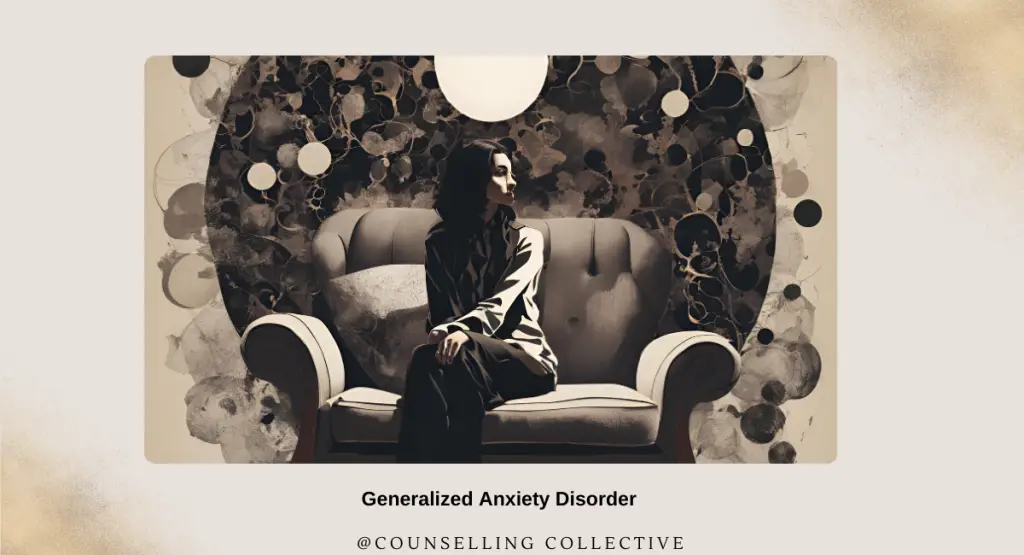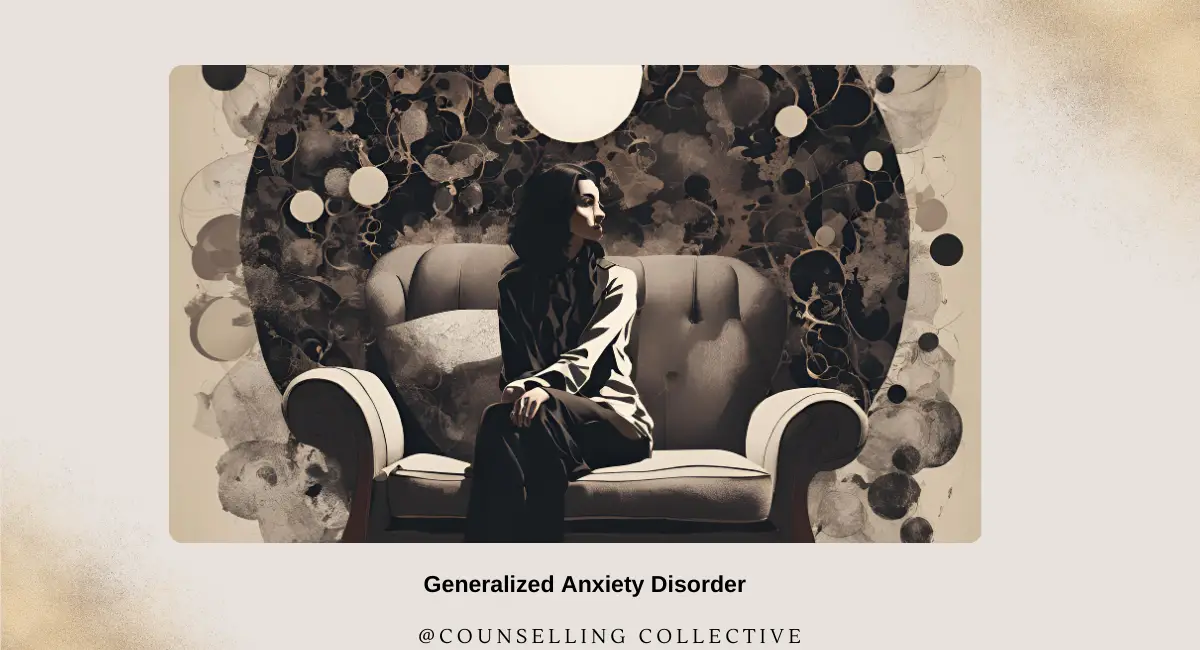
Generalized Anxiety Disorder (GAD): Symptoms, Causes, and Therapy Options
Contents
Introduction
Generalized Anxiety Disorder (GAD) is a common mental health condition marked by persistent and excessive worry about a variety of aspects in daily life, such as health, work, or finances. This worry is often difficult to control and occurs more days than not for at least six months, according to the Diagnostic and Statistical Manual of Mental Disorders, Fifth Edition (DSM-5). Unlike specific phobias, GAD is characterized by pervasive anxiety not linked to one particular event or object. Individuals with GAD experience a level of worry that is disproportionate to the actual risk, making it challenging to carry out daily activities.
The prevalence of GAD is significant, with approximately 6.8 million adults affected in the United States alone, according to the Anxiety and Depression Association of America (ADAA). This article aims to provide a comprehensive overview of GAD, outlining the types, symptoms, causes, and effective treatment strategies, along with long-term management techniques.
Common Symptoms of Generalized Anxiety Disorder
The symptoms of GAD are both psychological and physical, manifesting differently in each person. Here’s a comprehensive look at the common symptoms and their typical presentations:
| Symptom | Description/Example |
|---|---|
| Excessive Worry | Persistent and uncontrollable worry about everyday matters like finances or health, beyond rational concern. |
| Restlessness | Feeling on edge or unable to relax, even during low-stress situations. For example, pacing around the house frequently. |
| Fatigue | Constant tiredness despite adequate rest. Individuals may feel mentally drained due to chronic anxiety. |
| Difficulty Concentrating | An inability to focus on work or conversations, often caused by intrusive worrying thoughts. For instance, struggling to stay focused during a meeting. |
| Irritability | Increased frustration and quick temper, even over minor issues. For example, snapping at a partner over trivial matters. |
| Muscle Tension | Chronic tension in muscles, particularly in the neck, shoulders, and back. This can lead to headaches or other pain. |
| Sleep Disturbances | Difficulty falling asleep, staying asleep, or experiencing restful sleep. Individuals may wake up frequently during the night. |
Each of these symptoms may vary in intensity depending on the severity of GAD. Often, they occur in combination, making it hard for individuals to manage daily responsibilities.
Causes and Risk Factors of Generalized Anxiety Disorder
GAD develops due to a complex interaction of genetic, biological, and environmental factors. Researchers have identified several risk factors that may contribute to its onset.
1. Genetic Factors
There is a significant genetic component to GAD, with studies suggesting that about 30-40% of the variance in the development of the disorder is attributable to genetic factors. Individuals with a family history of anxiety disorders or depression are at a higher risk of developing GAD themselves. Twin studies support the idea that anxiety can be inherited, although the exact genes involved remain under investigation.
2. Neurobiological Factors
Certain areas of the brain, such as the amygdala and prefrontal cortex, play a crucial role in regulating fear and anxiety. Dysregulation in these brain areas can lead to heightened anxiety responses. Neurotransmitters like serotonin, norepinephrine, and gamma-aminobutyric acid (GABA) are also involved in mood regulation. A reduction in serotonin levels, for example, is often linked to increased anxiety and depressive symptoms, leading to the use of selective serotonin reuptake inhibitors (SSRIs) in treatment.
3. Cognitive Behavioral Factors
Cognitive models of GAD suggest that individuals with the disorder engage in negative thinking patterns, such as catastrophizing, where they expect the worst possible outcome in situations. They may also exhibit cognitive biases that lead them to perceive situations as more threatening than they really are. Cognitive theories, like those put forward by Aaron Beck, emphasize that maladaptive thought patterns fuel anxiety.
4. Environmental and Psychosocial Stressors
Life stressors, such as chronic financial problems, job instability, or relationship issues, can trigger or exacerbate GAD. Additionally, individuals who experience trauma, neglect, or adverse childhood experiences (ACEs) are more likely to develop GAD later in life. Long-term exposure to stressful environments can lead to increased activation of the body’s stress response system, perpetuating anxiety.
5. Personality Traits
Certain personality traits, such as neuroticism or perfectionism, are associated with a higher risk of developing GAD. Individuals who have difficulty handling uncertainty or those who are overly concerned with being in control often exhibit heightened anxiety in everyday situations.Therapy and Treatment Options for Generalized Anxiety Disorder
Therapy and Treatment Options for Generalized Anxiety Disorder
1. Cognitive Behavioral Therapy (CBT)
CBT is one of the most effective and widely used treatments for GAD. This therapy focuses on identifying and changing maladaptive thought patterns that contribute to anxiety.
Sarah, a 35-year-old teacher, constantly worries about being fired, even though her performance reviews are consistently positive. In CBT, Sarah learns to challenge her belief that any small mistake will lead to catastrophic consequences. Her therapist helps her create a thought record, where she writes down her anxious thoughts and analyzes the evidence for and against them.
2. Mindfulness-Based Cognitive Therapy (MBCT)
MBCT combines traditional cognitive therapy with mindfulness practices. It teaches individuals to observe their thoughts without judgment and helps them break the cycle of constant worry.
Example: John, a 42-year-old software developer, spends hours every day ruminating on potential future disasters, such as his family getting sick. In MBCT, John practices mindfulness meditation, learning to stay in the present moment rather than getting lost in his worries. By focusing on his breathing and observing his thoughts without reacting to them, John is able to reduce the mental energy he spends on worrying about things that may never happen.
3. Medication Management
Medication is often used alongside therapy, especially for individuals with moderate to severe GAD. Selective Serotonin Reuptake Inhibitors (SSRIs) SSRIs like sertraline and escitalopram are commonly prescribed for GAD. They work by increasing serotonin levels in the brain, which helps regulate mood.
Emily, a 28-year-old graduate student, experiences constant worry that interferes with her ability to focus on her studies. After discussing her symptoms with a psychiatrist, Emily starts taking escitalopram. His doctor prescribes a low dose of alprazolam to use only during high-stress periods. By using the medication in conjunction with therapy, Mark is able to manage his anxiety without becoming dependent on the drug.
4. Exposure Therapy
Exposure therapy is often used to help individuals confront their anxiety-provoking thoughts or situations. It involves gradually exposing the person to their feared situations until their anxiety decreases.
Example: Lisa, a 25-year-old marketing executive, avoids attending company meetings due to her fear of speaking in front of others. In exposure therapy, Lisa’s therapist helps her gradually confront her fear by first imagining herself in the meeting, then practicing speaking in front of a small group of friends.
5. Acceptance and Commitment Therapy (ACT)
ACT focuses on helping individuals accept their anxiety rather than trying to eliminate it. It encourages them to focus on their values and take action in line with those values, even when anxiety is present.
Example: Michael, a 30-year-old graphic designer, often avoids applying for new jobs due to his fear of rejection. In ACT, Michael works with his therapist to identify his core values, such as career growth and financial independence. His therapist helps him recognize that although his anxiety about job applications is valid, it doesn’t need to stop him from pursuing his goals.
Long-Term Management of GAD
Managing GAD is an ongoing process, even after initial treatment. Here are some effective long-term management strategies:
- Regular therapy sessions: Continuing therapy, such as CBT or ACT, can help maintain progress and prevent relapse.
- Daily mindfulness practice: Practicing mindfulness meditation can help individuals stay grounded in the present and prevent their worries from escalating.
- Exercise and lifestyle: Regular exercise has been shown to reduce anxiety by releasing endorphins and reducing muscle tension. A balanced diet and sufficient sleep are also essential for mental well-being.
- Support system: Maintaining close relationships with family, friends, or support groups can provide the emotional support needed to manage anxiety in the long term.
- Setting realistic goals: Breaking down tasks into manageable steps can help reduce the overwhelming feeling that often accompanies GAD. For example, if someone is anxious about completing a large project, breaking it into smaller, daily tasks can make it feel more achievable.
Conclusion
Generalized Anxiety Disorder is a complex and challenging condition, but it is manageable with the right treatment and support. Evidence-based therapies such as CBT, MBCT, and ACT, combined with medication, provide effective ways to reduce symptoms and improve quality of life. Long-term strategies, including stress management techniques and lifestyle adjustments, are essential for sustaining recovery. By seeking professional help and committing to therapy, individuals with GAD can lead fulfilling lives despite their anxiety.
References
- Kessler, R. C., et al. (2012). Twelve-month and lifetime prevalence and lifetime morbid risk of anxiety and mood disorders in the United States. Psychological Medicine.
- American Psychiatric Association. (2013). Diagnostic and Statistical Manual of Mental Disorders (5th ed.). Washington, DC: American Psychiatric Publishing.
- Beck, A. T., & Clark, D. A. (1997). Anxiety and depression: An information processing perspective. Anxiety Research.
- Hofmann, S. G., Asnaani, A., Vonk, I. J., Sawyer, A. T., & Fang, A. (2012). The Efficacy of Cognitive Behavioral Therapy: Generalized Anxiety Disorder A Review of Meta-analyses. Cognitive Therapy and Research.Generalized Anxiety Disorder
- Craske, M. G., & Barlow, D. H. (2006). Mastery of Your Anxiety and Worry (Treatments That Work). Oxford University Press.
- Roemer, L., & Orsillo, S. M. (2009). Mindfulness- and Acceptance-Based Behavioral Therapies in Practice. Guilford Press.
Explore Other Mental Health Issues








